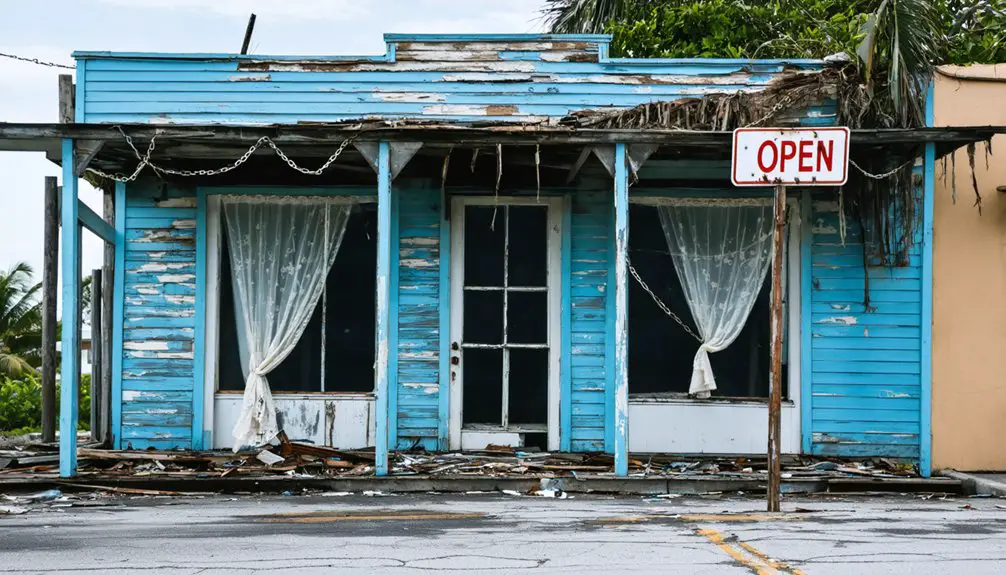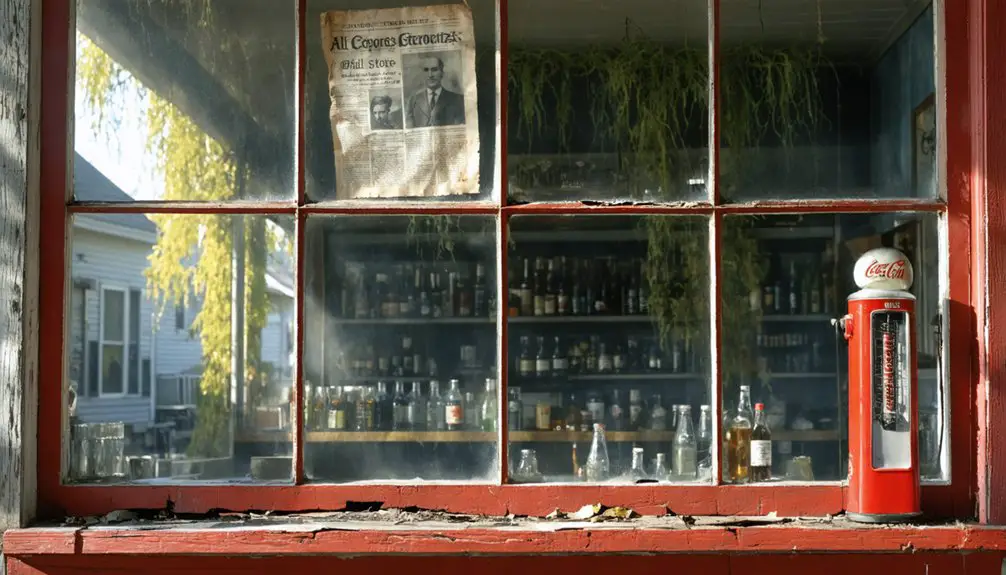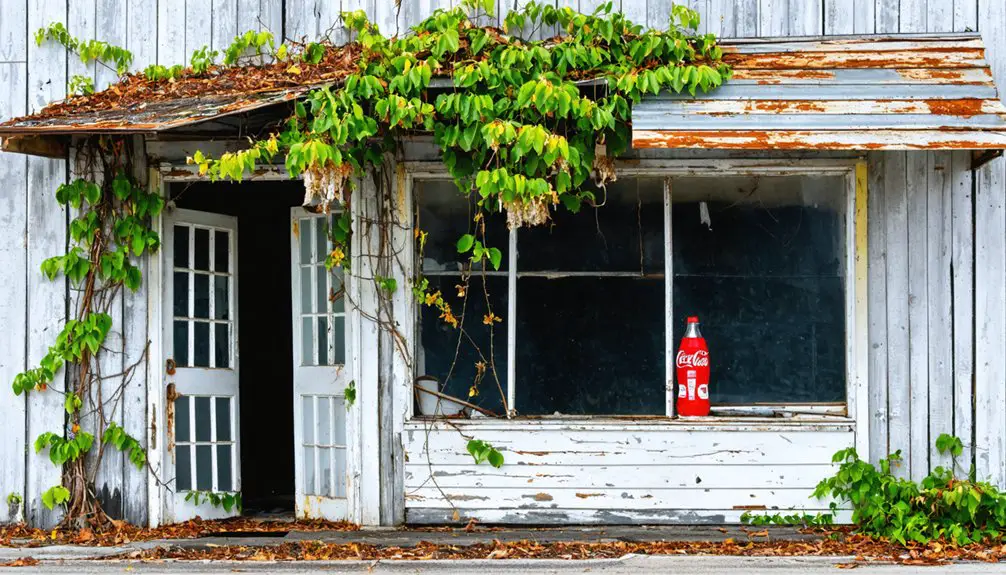You’ll find the ghost town of Perky at Mile Marker 17 in the Florida Keys, where Denver businessman Richter Clyde Perky established a luxury resort community in the 1920s. After purchasing 25,000 acres, including 50 islands, he transformed the former sponge-farming town of Chase into a bustling retreat with a lodge, marina, and his famous bat tower. Though Hurricane Irma destroyed the tower in 2017, Perky’s ambitious vision and quirky history still echo through the mangrove-lined shores.
Key Takeaways
- Originally named Chase, the town was renamed Perky after Richter Clyde Perky acquired 25,000 acres in the Florida Keys during the 1920s.
- The community flourished briefly with modern amenities, a post office, lodge, marina, and restaurant built around Perky’s vision of a luxury retreat.
- The town’s most iconic structure was the 30-foot bat tower, built in 1929 for mosquito control, which stood until Hurricane Irma destroyed it.
- Perky’s ambitious resort development plans never fully materialized, leading to the area’s gradual decline from a bustling community.
- The post office closed in 1942, marking a significant milestone in Perky’s transformation from an active town to a lesser-populated area.
The Vision of Richter Clyde Perky
Although born in Denver in 1879, Richter Clyde Perky would make his mark in Florida’s real estate market after relocating to Miami in the early 1900s.
By 1924, he’d amassed an impressive empire of 25,000 acres and over 50 islands in the Florida Keys, including half of Key Largo through his Island Holding Company.
Perky’s planning centered on transforming Sugarloaf Key into an exclusive retreat near Mile Marker 17.
Perky envisioned Sugarloaf Key as a secluded paradise, strategically positioning his upscale development at Mile Marker 17.
Clyde’s aspirations led him to develop essential infrastructure, including Sugarloaf Boulevard connecting to the main highway. He built a lodge, marina, restaurant, and guest cottages to attract wealthy visitors. His ambitious plans included a 30-foot bat tower designed to control the mosquito population. Before his development, sea travel was the only way to access the area until rail service began in 1912.
His influence grew so greatly that the local railroad depot was renamed “Perky” in his honor, cementing his vision for a luxurious Keys destination.
From Chase to Perky: A Town’s Transformation
Before Richter Clyde Perky‘s ambitious vision took shape, the area existed as a modest plantation town called Chase.
The Chase history began when Dr. Harris of Key West sold his land to the Chase brothers, who established the Florida Keys Sponge and Fruit Company. Despite their efforts, commercial sponge farming proved unsuccessful in the area.
The 1920s marked a pivotal shift when Richter Clyde Perky acquired the land rights, setting his sights on transforming the small town of 500 residents into a resort destination. His most notable contribution was the construction of the historic bat tower in 1929. The tower’s construction, costing nearly ten thousand dollars, represented a significant investment in the area’s development.
You can trace the Perky legacy to 1924 when his Island Holding Company amassed an impressive 25,000 acres across the Florida Keys, including 10,000 acres on Key Largo.
The town’s name change from Chase to Perky reflected this transfer of power and the dawn of a new era.
The Famous Bat Tower Experiment
Among Perky’s most ambitious ventures was the construction of a 30-foot wooden bat tower in 1929, designed to control the area’s mosquito population through natural means.
You’ll find the tower’s story fascinating: Richter Clyde Perky spent nearly $10,000 following Dr. Charles Campbell’s Texas bat roost designs, hoping to revolutionize mosquito control through bat behavior manipulation.
The project included a mysterious bat bait made from guano and bat organs, costing up to $500. Despite careful planning and construction at Mile Marker 17 on Lower Sugarloaf Key, the tower failed to attract its intended residents.
Local legends claim 1,000 bats were released but never returned. The structure stood as a historic landmark until Hurricane Irma destroyed it in 2017, marking the end of Perky’s innovative but unsuccessful experiment. The tower’s purpose was to house bats that would help combat malaria-spreading mosquitoes in the Lower Keys.
Resort Dreams in the Florida Keys
The ambitious Richter Clyde Perky didn’t limit his Florida Keys vision to bat-based mosquito control. By 1924, he’d assembled an empire of 25,000 acres, including over 50 islands and vast tracts of Key Largo he dubbed “Perkyland.”
You’ll find his grand plans centered around Mile Marker 17 on Sugarloaf Key, where he dreamed of creating a luxury fishing paradise for wealthy visitors. His most notable addition was the 30-foot Gothic tower designed to combat the persistent mosquito problem.
To transform this mosquito-infested stretch into a tropical tourism hotspot, Perky invested heavily in infrastructure. He subsidized road construction to connect his planned resort to State Road 4-A, and developed a property complete with lodge, marina, restaurant, and guest cottages.
Though his original vision faced challenges, it laid groundwork for future development, including the 1950s Sugarloaf Lodge that would carry his legacy of Keys hospitality forward.
Life in Early Perky: Community and Commerce
While many Florida Keys settlements struggled to establish permanent communities in the 1920s, Perky emerged as a bustling town of 500 residents near mile marker 17 on Lower Sugarloaf Key.
The town thrived with modern amenities, including electricity, water, telephone, and telegraph services – luxuries rare in rural Keys communities of that era.
You’d find community gatherings centered around the Sugarloaf Lodge, which served as both a social hub and tourist destination.
The fishing economy drove local commerce, with docks and marinas supporting both commercial operations and recreational activities.
To maintain clear navigation throughout the area, Perky established a system of direct article links to connect different parts of the community.
The post office, established in 1929, became a crucial connection point for residents until its closure in 1942.
Local businesses catered to wealthy tourists, offering lodging, dining, and guided fishing experiences in the surrounding waters.
The Sugarloaf Lodge Legacy
Sugarloaf Lodge emerged as a pivotal development in the late 1950s when Pennsylvania’s Reimersburg Coal Company established it during their dredging operations at Sugarloaf Shores.
In the Florida Keys, Sugarloaf Lodge rose from dredging operations to become a landmark destination in the 1950s.
You’ll find that Sugarloaf history took shape as residential communities grew alongside the lodge, with sections A and B completed before 1961.
The lodge’s evolution included a significant expansion in the early 1960s, adding a restaurant and a two-story motel raised five feet to combat hurricane threats.
Lloyd and Miriam Good’s 1973 purchase marked a new chapter in lodge preservation, as they maintained it as a family operation for nearly five decades.
While the original one-story motel stood strong for years, Hurricane Wilma finally claimed it in 2005, marking the end of an era in the Florida Keys’ hospitality landscape.
Hurricane Irma’s Destructive Impact

You’ll find that Hurricane Irma‘s most symbolic destruction in Perky came on September 10, 2017, when the Category 4 storm toppled the historic Sugarloaf Key Bat Tower.
The hurricane’s devastating winds and storm surge destroyed 1,179 buildings across Monroe County, with homes near Perky ripped from their foundations and extensive damage to coastal protection structures.
The storm’s aftermath left the landscape transformed into a wasteland of brackish water and dead trees, while knocking out critical infrastructure including power, water, and transportation access along the Overseas Highway. Houses that survived the hurricane’s fury were primarily those built on elevated stilts for protection against flooding.
Big Pine Key and surrounding areas endured the most catastrophic damage during the hurricane’s passage through the Florida Keys.
Tower’s Final Moments
In September 2017, Hurricane Irma‘s devastating winds spelled the end for Perky’s iconic bat tower on Sugarloaf Key. You won’t find a single photograph capturing the tower’s final moments, but the Category 4 hurricane’s 130-140 mph winds proved too powerful for the aging wooden structure.
Built in 1929, the tower stood exposed and vulnerable, lacking modern reinforcements or hurricane-resistant modifications. As Irma’s storm surge and intense rainfall battered the lower Florida Keys, the historical significance of this standalone landmark couldn’t save it from nature’s fury. The water whiteout conditions made it impossible to witness or document the tower’s collapse.
While surrounding structures like the old fishcamp survived with damage, the bat tower succumbed completely to Irma’s wrath. The tower’s destruction marked a profound loss for Perky’s cultural heritage, forever changing the landscape of this once-thriving Florida Keys community.
Storm Damage Assessment
The devastating impact of Hurricane Irma extended far beyond the fallen bat tower, wreaking havoc throughout Monroe County and the Florida Keys.
You’ll find that the storm destroyed 1,179 buildings across the region, with extensive damage to coastal armoring and protective structures essential for shoreline stability.
In Perky’s vicinity on Lower Sugarloaf Key, the destruction was particularly severe. While the historic fishcamp building survived and later reopened as a restaurant, many surrounding structures lost their roofs and foundations.
Storm recovery efforts were hampered by debris-blocked access to the Overseas Highway and widespread utility outages.
The Florida DEP’s Emergency Hurricane Group focused on evaluating beach erosion, while aerial photography from NOAA helped document the compromised structural integrity of buildings throughout the coastal communities.
Natural Beauty and Geographic Features
As you explore Perky’s pristine coastal waters, you’ll find extensive seagrass beds and mangrove forests that characterize the Lower Sugarloaf Key shoreline.
You can observe the rich marine biodiversity in Upper Sugarloaf Sound, where tidal flows support various fish species, crustaceans, and occasional marine mammals.
The surrounding tropical hardwoods and salt-tolerant vegetation provide essential habitats for both migratory and resident birds, creating a vibrant ecosystem at 24.649°N latitude and 81.572°W longitude.
Pristine Coastal Waters
Located within the Florida Keys geological subprovince, Perky’s pristine coastal waters flow across an ancient limestone foundation shaped by millions of years of marine activity.
You’ll find a dynamic coastal ecology where shallow basins and banks create diverse aquatic habitats, supporting vibrant seagrass beds and coral reef remnants.
The waters’ unique circulation patterns sustain surrounding mangrove swamps and tidal mud flats, while varying salinity levels foster rich marine biodiversity.
As you explore, you’ll discover waters teeming with microscopic marine life that continuously contributes to the carbonate sands and muds below.
These pristine conditions maintain essential water clarity and nourish the coastal prairies and salt-tolerant vegetation communities that line Perky’s shores, creating a thriving ecosystem that’s remained largely untouched.
Keys Flora and Fauna
Perky’s rich coastal ecosystem extends beyond its waters into a diverse landscape of tropical hardwood hammocks and mangrove forests.
You’ll find a delicate ecological balance where native species thrive, from endangered Lower Keys marsh rabbits to migratory warblers seeking refuge during their seasonal journeys. The limestone bedrock supports a unique collection of flora, including gumbo limbo and mahogany trees inland, while red, black, and white mangroves form natural barriers along the shoreline.
- Great egrets and snowy egrets wade through sawgrass marshes and salt ponds
- Native orchids and bromeliads add splashes of color to the hardwood hammock
- Raccoons and bats make their home among the tropical vegetation
- Brown pelicans and frigatebirds soar above the mangrove-fringed coastline
Notable Visitors and Cultural Impact

Throughout its history, the sleepy ghost town of Perky attracted several notable figures, most famously Hunter S. Thompson, who frequented the Sugarloaf Lodge during the 1970s and 1980s.
The area’s cultural significance grew from Richter Clyde Perky’s initial vision of a fishing retreat to a unique destination featuring the innovative Bat Tower, which stood as one of only three such structures until Hurricane Irma destroyed it in 2017.
The iconic Bat Tower transformed Perky from a simple fishing spot into an eccentric landmark before Irma’s fury toppled it forever.
The tourism evolution of Perky reflects its transformation from an ambitious 1920s development to a counter-cultural haven.
You’ll find Thompson’s legacy in the “Gonzo Tours” that once operated from Sugarloaf Lodge Marina, while the area’s fishing, snorkeling, and diving amenities continue to draw visitors.
Even as a ghost town, Perky’s quirky history and natural attractions maintain its appeal to freedom-seeking adventurers.
Frequently Asked Questions
What Happened to Richter Clyde Perky After His Town Project Failed?
You won’t find much about Perky’s project aftermath, as records don’t detail his activities after the town’s decline. His legacy endures mainly through the failed Bat Tower and Keys development attempts.
How Many Original Residents Still Live in Perky Today?
You won’t find any original population living in Perky today – all current residents have departed since the town’s decline after 1942, leaving behind only repurposed structures and tourist facilities.
Were There Any Other Bat Towers Constructed in Florida?
Like a lone sentinel against mosquitoes, the Sugarloaf Key Bat Tower stood as Florida’s only Campbell-designed bat conservation structure. You won’t find any other tower architecture of this type throughout the state.
What Was the Total Cost of Building the Bat Tower?
You’ll find the bat tower construction cost totaled $10,000 in 1929, which included your basic cost breakdown of lumber, labor, architectural plans, and an extra $500 for Campbell’s special bat bait.
Did Perky’s Family Maintain Any Ownership Rights in the Area?
While Perky’s ownership initially spread across multiple companies in the Florida Keys, there’s no clear record showing his family maintained lasting property rights after the legal disputes of the 1930s.
References
- https://tisqui.github.io/2017/12/28/Perky.html
- https://en.wikipedia.org/wiki/Perky
- https://fla-keys.com/keysvoices/the-strange-saga-of-the-bat-tower/
- https://keysweekly.com/42/keys-history-lower-keys-bat-tower-was-a-roadside-attraction/
- https://keysweekly.com/42/keys-history-sugarloaf-restaurant-a-junction-between-former-railroad-highway/
- https://www.keyshistory.org/SL-Sugarloaf-Key.html
- https://keysweekly.com/42/keys-history-wife-of-righter-perky-made-her-own-news/
- http://tonyshaw3.blogspot.com/2015/03/perkys-bat-tower-sugarloaf-key-florida.html
- https://www.archpaper.com/2017/10/bat-tower-hurricane-irma-sugarloaf-key/
- https://npgallery.nps.gov/GetAsset/ec7b09f7-19db-4c96-8170-e0efaca829a3



